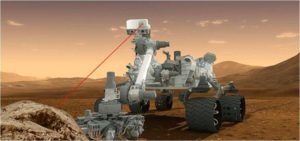
Odd object imaged by Curiosity’s Mastcam Right image taken on Sol 1577, January 12, 2017. Now confirmed as iron-nickel meteorite.
Credit: NASA/JPL-Caltech/MSSS
NASA’s Curiosity rover has indeed found another iron-nickel meteorite, now called “Ames Knob,” on the surface of the Red Planet.
As reported earlier on Inside Outer Space, the object spotted by the robot is mostly iron, some 90 percent iron with a small amount of nickel, says Roger Wiens, Curiosity’s Chemistry & Camera (ChemCam) principal investigator for the Mars Science Laboratory rover effort at Los Alamos National Laboratory in New Mexico.
Laser shots
“Yes, indeed, we did a brief compositional analysis of Ames Knob with ChemCam, with just three laser locations,” Wiens told Inside Outer Space.
In October 2016 the rover found a similar iron-nickel meteorite dubbed “Egg Rock.”
Wiens said: “While one observation point of Egg Rock showed the presence of phosphorous, we did not observe any of this element in Ames Knob. It is still likely that Ames Knob is the same meteorite type and may have fallen at the same time as Egg Rock.”
4th find by Curiosity
Ames Knob is approximately 4 x 6 inches in size (10 x 14 centimeters), Wiens adds. “On Earth it would weigh about 0.8 kg or a little less than 2 pounds. We observed it from about 10-feet (3.4 meters) distance.”
It is the 4th meteorite to be found by the Curiosity rover, Wiens pointed out.
The third one, Egg Rock, was found and analyzed by ChemCam on sol 1505. It was somewhat smaller, at about 5 cm diameter. The first two meteorites, Lebanon and Littleton, were both quite large, at over 1 meter in length, and were imaged around sol 634, a little less than 5 kilometers [3 miles] from where the rover is now, Wiens pointed out.

October 30, 2016 image taken by Curiosity on Sol 1505. This iron-nickel meteorite was dubbed “Egg Rock.”
Falling on land…or water?
“All of these are iron meteorites,” Wiens notes, “are relatively easy to distinguish from the Mars rocks.”
The pre-Curiosity Mars Exploration Rover (MER) – Spirit and Opportunity — also found several meteorites on Mars.
“We hope that meteorites will be able to tell us some information about the Mars environment, such as whether they fell on land or in water, or how dense the atmosphere was when they fell,” Wiens explains.



Was extremely disappointed as I was hoping to catch your talk at our local library in Longmont, Co. However you’re so dang popular that you’re sold out. Must be a lot of marstians. 🙂
I’m puzzled by the idea that these meteorites might have fallen into water but if so, surely they would have rusted to shale balls, or even been destroyed, no? Wouldn’t the oxygen in the water prove oxidizing enough to rust them even in the absence of significant atmospheric oxygen? Or are the scientists assuming that the meteorites were much larger in the past and were scoured free of rust after the water disappeared? Or are they looking at the surrounding dirt and rock and seeing evidence of mud?